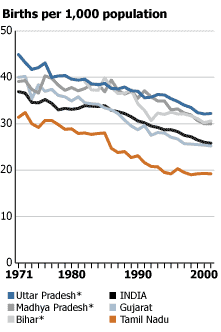Carl Haub
Former Demographer Emeritus

March 28, 2002
Former Demographer Emeritus
(March 2002) The annual count of births in India over the last few years has provided increasing evidence of a slowdown in the decline of the birth rate of the world’s second most populous country.
Vital rates from the country’s Sample Registration System, which have just become available for 2000, confirm what has recently been suspected: Fertility decline has reached a classic “plateau,” with the downturn coming to an end, at least for now.
This development is particularly noteworthy in light of the Expert Group Meeting on Completing the Fertility Transition, held March 11 to 14 by the United Nations Population Division. The conference focused on the prospects for fertility decline in countries with intermediate levels of birth rates — those where couples have an average of fewer than five children but more than the 2.1 level required to “replace” themselves in the population. Such countries include India, Indonesia, and Brazil. The conference discussed whether birth rates in these countries would decline to 2.1 children per couple, level out above it, or decline even further.
In the case of India, some in the expert group remarked that this country of roughly 1.1 billion people is a case where birth rates at the state level are particularly important given the wide variations among the populous northern states and the effect those states have on the national rate.
India has the world’s oldest population policy, having recognized rapid population growth as a serious national concern as early as 1952. At that time, women in India averaged about six lifetime births. With mortality rates falling, particularly maternal and infant rates, India’s population, which was about 350 million at Independence in 1948, was growing at an ever-increasing rate.
Since the inception of India’s population policy, fertility has fallen in fits and starts. By 2000, women were having an average of about 3.3 children. As has often been observed, a good part of the national fertility decline occurred in the southern states, which generally have higher rates of literacy and education, along with greater equality for women. In the graph, one such example is Tamil Nadu — a state where birth rates have declined to about two children per woman, but which also started from a lower level.

* In late 2000, Uttar Pradesh, Bihar, and Madhya Pradesh were each split into two states. Rates and populations shown above are pre-breakup.
Source: Registrar General of India, Sample Registration System Bulletin 35, no. 2.
Many agree that future fertility decline in India must come from the large and highly illiterate northern states in the so-called “Hindi belt.” In the graph, birth rates for Uttar Pradesh (population of 175 million at the 2001 Census), Bihar (110 million), and Madhya Pradesh (81 million), along with Gujarat (51 million) are shown as representative examples. Here, the slowdown in the decline is evident, and a similar conclusion could be reached for major states such as Maharashtra, Rajasthan, and West Bengal, among others.
India is among the very few developing countries with birth, death, and infant mortality rates available annually. The Sample Registration System surveys nearly 7,000 rural and urban sampling units monthly to ascertain the number of births and deaths. While some undercounting is likely, this system, which became fully operational in the early 1970s, is now widely accepted as an invaluable indicator of demographic trends in the country.
India’s National Population Policy 2000 calls for the country’s fertility to reach the “replacement level” of about 2.1 children by 2010 so that population growth would eventually reach zero. But for this to happen, there must be an accelerated fertility decline in the high-fertility states of the north. There is a key point here: if significant fertility decline does not resume, the populations of these large states will grow more rapidly, gaining an ever-increasing share of the national population. In that event, fertility could even rise, a possibility that has not yet caught the attention of planners.
What are the prospects? Is fertility decline to replacement level becoming a distant dream in India? Certainly, fertility decline moves in differing patterns (notice the definite plateau in the rate for all-India in the 1980s, following the unpopular sterilization campaigns of the late 1970s), but there has been a noticeable tendency for high-fertility countries to decline fairly rapidly from those high levels and then “stall” at medium levels. Recent examples of this are Bangladesh, Egypt, and Turkey. If this proves to be India’s fertility future, population projections will have to be rewritten once again.
Carl Haub is a senior demographer at the Population Reference Bureau.
